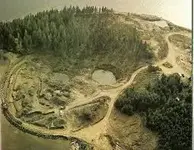Schlechter
Jr. Member
- Joined
- Jan 21, 2016
- Messages
- 24
- Reaction score
- 23
- Golden Thread
- 0
- Primary Interest:
- All Treasure Hunting
Also, about people not believing in the flood tunnels. You often mention...well anywhere they dig they get water, yes ground level water. Forgive me for not being technical with my wording but this is how I understand the levels of earth.
There is a natural ground level where water flows, but its not like once you get below that all there is a river of water. And typically when you reach this water level, the water doesnt come flooding in, it just sorta trickles into the area and fills it (likely from the near surrounding dirt that is holding small amounts of water). There is no river of water that will rush in when you dig this deep and once you have dug out this sitting water it should not continue to fill (at least not at a significant rate).
Also, I dont believe that there is high levels of water in the clay or slate levels of the ground, these levels would typically form the bottom level...or bedrock? This pit far exceeds the ground water level and goes through various layers that would not allow water to get any deeper. What each person who has tried to dig out the pit explains is water FLOODING the pit. This would indicate that the amount of water rushing in far exceeds the natural influx of ground water. I believe they also indicate that it is salt water that floods the pit and not fresh water that would typically make up normal ground water (like when you dig a well). Therefore the only explanation is that there are tunnels connecting to the ocean where the water is salty and not been filtered by the earth and that once it has been breached the salt water floods into the pit and fills it up to sea level.
This is why the builders of the pit created layers of "blue clay" that would form a water tight barrier and not allow ground level water to get to the deeper layers of the pit.
I thought you guys on this forum were smarter than this?
There is a natural ground level where water flows, but its not like once you get below that all there is a river of water. And typically when you reach this water level, the water doesnt come flooding in, it just sorta trickles into the area and fills it (likely from the near surrounding dirt that is holding small amounts of water). There is no river of water that will rush in when you dig this deep and once you have dug out this sitting water it should not continue to fill (at least not at a significant rate).
Also, I dont believe that there is high levels of water in the clay or slate levels of the ground, these levels would typically form the bottom level...or bedrock? This pit far exceeds the ground water level and goes through various layers that would not allow water to get any deeper. What each person who has tried to dig out the pit explains is water FLOODING the pit. This would indicate that the amount of water rushing in far exceeds the natural influx of ground water. I believe they also indicate that it is salt water that floods the pit and not fresh water that would typically make up normal ground water (like when you dig a well). Therefore the only explanation is that there are tunnels connecting to the ocean where the water is salty and not been filtered by the earth and that once it has been breached the salt water floods into the pit and fills it up to sea level.
This is why the builders of the pit created layers of "blue clay" that would form a water tight barrier and not allow ground level water to get to the deeper layers of the pit.
I thought you guys on this forum were smarter than this?
Last edited:







